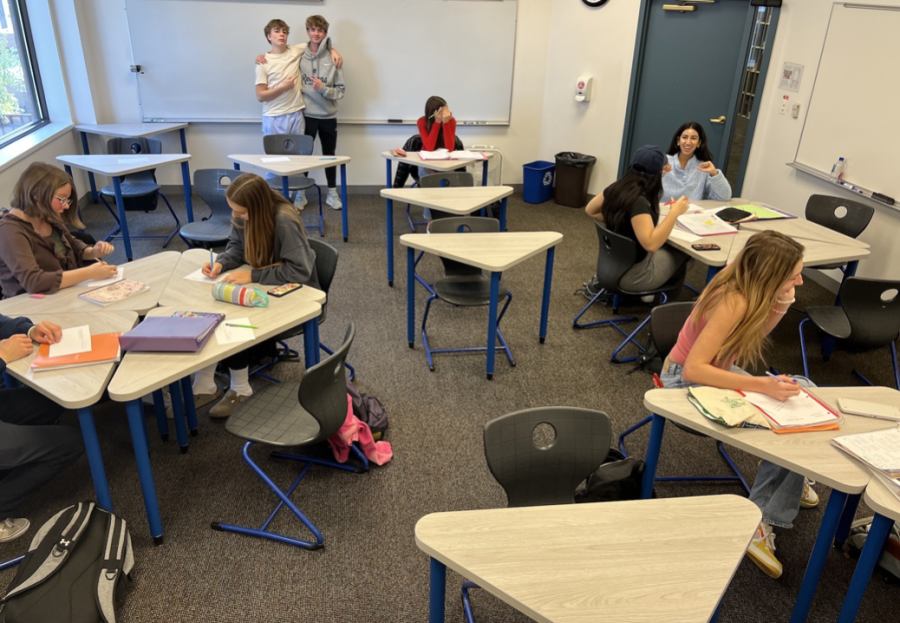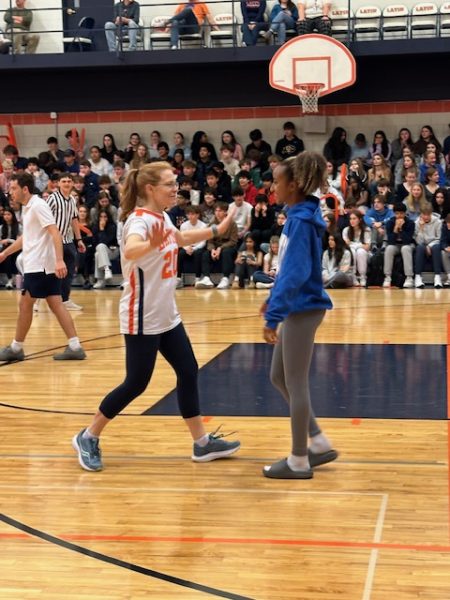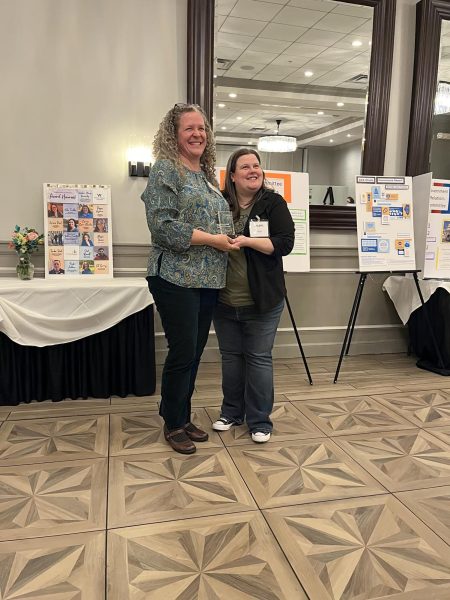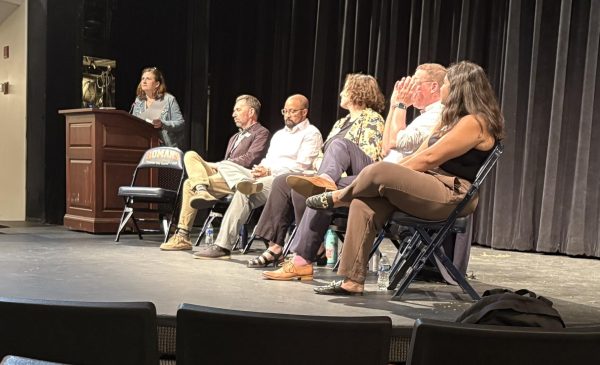New Dorito Desks Cause a Ruckus
Another not-as-popular configuration of the Dorito desks being displayed in US330 is pure chaos.
At the start of the 2022-23 school year, students were greeted with not only a new Head of School and a closed Bridge Cafe door but also new furniture in nearly every Upper School classroom: triangular desks (more formally known as Dorito desks).
In her first year at Latin, US Division Director Kristine Von Ogden observed more than 50 classes in an effort to identify potential improvements in the school. “We had so much space that was not being used well, or [the space] was just really clunky and restrictive,” Ms. VO said. “I saw classrooms where the desks were so heavy that students couldn’t move them around, and it was impeding what the faculty wanted to do in the classroom.”
So this year, she, along with the facilities team, replaced the majority of the desks in the US. They purchased “nesting desks,” which can be put in pods or moved around to any configuration. She pictured desks similar to the ones in US classrooms 229, 230, and 302: a triangular shape on wheels.
Latin bought around 300 Ruckus Post Leg Desks from KI, according to Assistant Director of Buildings and Grounds Joe Schubert. The list price for each desk, a fixed-height wooden triangle with no wheels, is approximately $273.
The Illinois District Manager for KI, Bob Stefan, said, “The Latin School buys at a great discount for their larger projects, but the discount varies based on volume and whatever contract that they are using to purchase.” He added, “Most of the time it is in the range of 48 percent to 50 percent off of list, sometimes even deeper. So, for a product with a list price of $273, they would be buying the product in the $130-$140 range per desk, maybe a little less.”
Latin’s Chief Financial Officer Michael Szczepanek said, “Each year we allocate funds to support the renewal and replacement of campus equipment, furniture, technology, and other items essential to the functionality of our buildings and programs. The replacement of desks in the Upper School was just one of many capital investments identified and made last year across campus.”
Feedback on the desks has been mixed, possibly because students and faculty members weren’t consulted before the school bought the new furniture. Upper School history teacher Deborah Linder said, “One thing that I have always learned is that when people have a say in the process of choosing desks, they are much less likely to complain. When people feel like they have some sort of understanding of what is going to happen and how they might be able to make suggestions, there is less frustration.”
Xavier Espejo-Vadillo, Upper School Language Department Chair and Upper School Project Week Coordinator, said that faculty members were “surprised that we got them.”
Some of the feedback has been decidedly negative.
Insightfully, senior Evan Jones said, “They suck.”
Freshman Sydney Dibble said, “They’re too light and they’re too easy to tip over. I almost fall every day.”
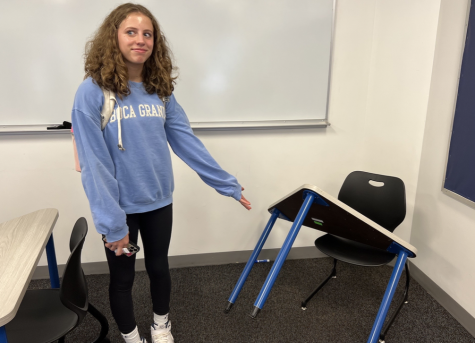
Similarly, Ms. Linder said, “They tip over if you want to sit on them, which I know sounds silly, but sometimes you just want to lean on a desk.”
In terms of why the desks are tipping over, Upper School physics teacher Steven Coberly said, “It tips [at the long edge] because the center of mass is [closer to the edge] and the legs are moved in from the side. So you don’t have to tip it very far before the center of mass is outside where the legs are. You can fix that by just moving the legs out a little and then it would be a lot more stable.”
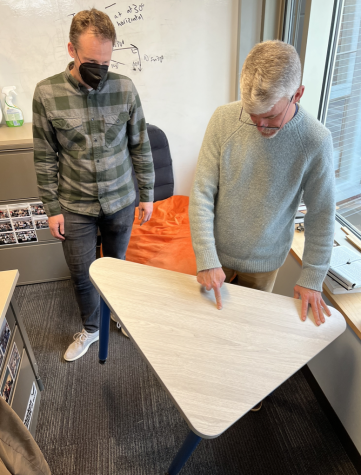
However, some faculty members and students were pleased to find that their classrooms were now crowded with the triangle desks. Upper School math teacher Zach McArthur said, “I like them because they’re easy to move around, and I like my kids working in groups a lot.”
Junior Winston Spreitzer said, “I think the desks are very effective in arranging kids across a classroom because they can fit up to eight people in a pod very nicely. They also are much larger than the desks we have had in the past, so it is easier to work on them.”
Although they may feel wider than the old desks, the new triangular desks have almost half the surface area of the old rectangles, with just a 2.94 square foot surface.
“I can’t do my work if I am using more than one thing,” senior Eve Drumm said. “Especially for whole group discussions when I need all my notes and stuff, I don’t like it. The other ones weren’t that hard to move. They were a little heavier, but the triangle shape is the problem.”
One of the main reasons Ms. VO wanted to purchase this type of desk was to have the ability to reconfigure a room quickly before a class starts. Different subjects often need different set-ups. Math classes, for example, are often taught in pods, while English and history classes are taught in U shapes to facilitate discussions.
Ms. VO said, “Because they’re light, they’re maneuverable; you can have some people work on their own, and you can have some people work in groups.” Despite Ms. VO initiating the desk replacement, she added, “I did not know exactly which desks were going to get ordered, so the fact that they’re a little more Dorito-y than I had imagined is pretty funny.”
These Dorito-shaped desks are on “gliders,” meaning they do not have wheels but should be easily movable. Notably, though, they are on carpet, which makes moving them more difficult. To buy them on wheels would have come with no extra cost.
Ms. Linder said, “The biggest concern is not about the desks themselves, it’s about where the other desks went. I want to know.”
Mr. Schubert provided an explanation, saying, “We attempted to donate them, but nobody wanted them. We went through [Director of Student Life Tim] Cronister as well, and nobody is taking furniture these days. With the pandemic, everybody’s trying to dump stuff on everybody, and basically everybody’s just stockpiling right now. We scrapped them.”
If you are looking for a rectangular desk in the school, give up; they were all thrown out.
Junior Will Turula said, “I’m definitely kind of sad that they just tossed them, because I didn’t see anything wrong with the last ones.”
Additionally, some students are growing increasingly frustrated with the lack of legroom the desks have to offer. A very concerned senior, Timothy Hesse, said, “There is a post right where you are supposed to put your legs. You have to either straddle the post or put the post to one side or put the post to the other side, and it’s annoying.”
Junior Michael Wissink said, “There’s no leg room. I can’t be stretching my legs.”
Whether it be the desks’ lack of mobility, shape, or amount of legroom, the community is engaged in fierce debate. Ms. VO encourages all students to offer her their feedback, saying, “I know that one-size-fits-all certainly when it’s a Dorito doesn’t work for everybody. But I do think, overall, it’s been a nice improvement for the school.”
The Dorito desks are here to stay. And with time, the community will likely adapt. “Generally I think that learning can happen with these desks or without them,” Mr. McArthur said.
Ms. Linder added, “Maybe I’ll learn to love these triangle desks and be sad when they’re gone. We have to keep our minds open.”
So the question to be asking: Will the chairs be next?

Eliza Lampert (’24) is a senior at Latin and is overjoyed to serve as one of this year’s Editors-in-Chief. During her time writing for The Forum, she...


















































